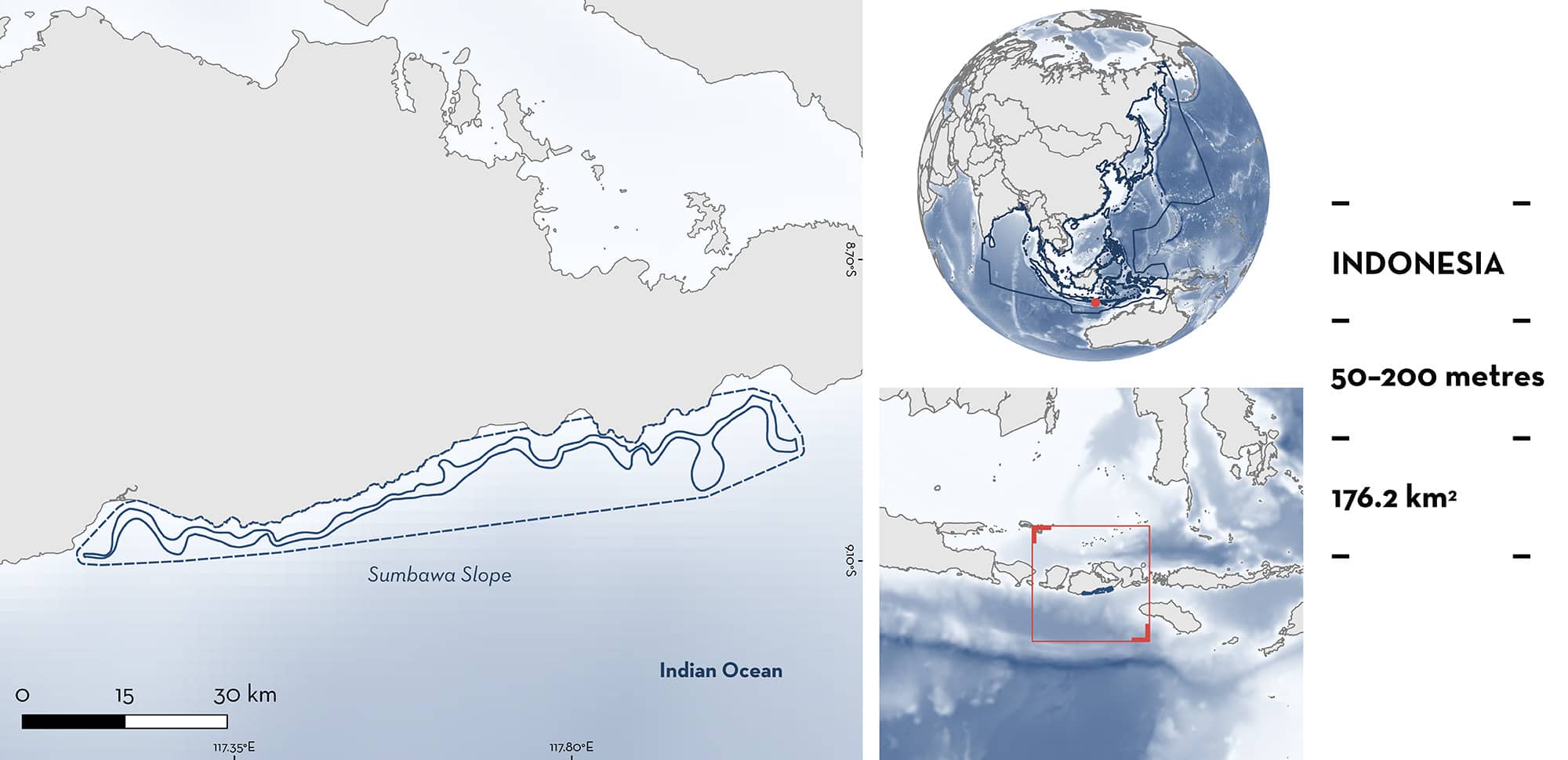ISRA FACTSHEETS
ISRA FACTSHEETS
ASIA REGION
Sumbawa Slope
Summary
Sumbawa Slope is located off southern Sumbawa Island, Indonesia. The area includes the break between the shelf and the slope and is characterised by the presence of submarine canyons. The area overlaps with the Lunyuk Tatar Sepang marine protected area. Within the area there are: threatened species (Indonesian Shortsnout Spurdog Squalus hemipinnis); and range-restricted species (e.g., Indonesian Speckled Catshark Halaelurus maculosus).
Download factsheet
Sumbawa Slope
DESCRIPTION OF HABITAT
Sumbawa Slope is located off southern Sumbawa Island in the West Nusa Tenggara Province of southern Indonesia. The area includes the break between the shelf and the slope and is characterised by the presence of submarine canyons along the wide portion of the slope (~5 km).
The area is influenced by monsoon winds. The northwest monsoon (December to February) brings low-speed winds and high rainfall while the southeast monsoon (June to August) brings high-speed winds and lower precipitation (Wirasatriya et al. 2021). These winds induce coastal upwellings across the area that cause phytoplankton and zooplankton blooms, especially during the southeast monsoon (Simanjuntak & Lin 2022). In addition, in the southern part of the area, upwellings are produced by the El Nino-Southern Oscillation (Simanjuntak & Lin 2022).
The area overlaps with the Lunyuk Tatar Sepang marine protected area.
This Important Shark and Ray Area is benthopelagic and subsurface and is delineated from 50 m to 200 m based on the bathymetry and the depth range of the Qualifying Species in the area.
CRITERION A
VULNERABILITY
One Qualifying Species considered threatened with extinction according to the IUCN Red List of Threatened Species regularly occurs in the area. This is the Vulnerable Indonesian Shortsnout Spurdog (Dulvy et al. 2020).
CRITERION B
RANGE RESTRICTED
This area holds the regular presence of Indonesian Speckled Catshark and Indonesian Shortsnout Spurdog as resident range-restricted species.
Between 2014–2022, 47 Indonesian Speckled Catsharks were recorded year-round in landing surveys from demersal longline fisheries operating in the area (BM Simeon unpubl. data 2023). In Indonesia, this species has been sporadically recorded in small areas on the southern side of Java, Bali, and Sumbawa but has not been confirmed to occur regularly in any other location, confirming the importance of Sumbawa Slope for the species.
Between 2016–2018, 231 Indonesian Shortsnout Spurdogs were recorded during landing surveys of demersal longline fisheries operating in the area (BM Simeon unpubl. data 2023). A larger number of individuals were recorded between November and February. This area is one of only two locations where the regular presence of this species has been recorded outside of southern Java (BM Simeon unpubl. data 2023).
The Indonesian Shortsnout Spurdog is endemic to the Indonesian Sea Large Marine Ecosystem (LME) and its distribution is restricted to eastern Indonesia, known only from the southern side of Java, Bali, Lombok, and Sumbawa. The Indonesian Speckled Catshark occurs in the Indonesian Sea LME and the Sulu-Celebes Sea LME.
Download factsheet
SUBMIT A REQUEST
ISRA SPATIAL LAYER REQUEST
To make a request to download the ISRA Layer in either a GIS compatible Shapefile (.shp) or Google Earth compatible Keyhole Markup Language Zipped file (.kmz) please complete the following form. We will review your request and send the download details to you. We will endeavor to send you the requested files as soon as we can. However, please note that this is not an automated process, and before requests are responded to, they undergo internal review and authorization. As such, requests normally take 5–10 working days to process.
Should you have questions about the data or process, please do not hesitate to contact us.


